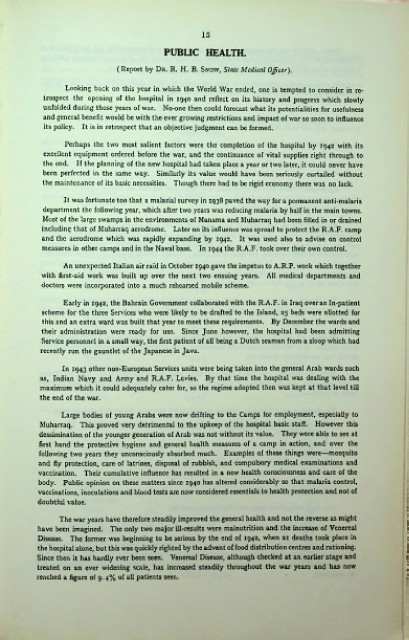Page 223 - Bahrain Gov Annual Reports (III)_Neat
P. 223
15
PUBLIC HEALTH.
(Report by Dr. R. H. B. Snow, State Medical Officer).
Looking back on this year in which the World War ended, one is tempted to consider in re
trospect the opening of the hospital in 194° an(l reflect on its history and progress which slowly
unfolded during those years of war. No-one then could forecast what its potentialities for usefulness
and general benefit would be with the ever growing restrictions and impact of war so soon to influence
its policy. It is in retrospect that an objective judgment can be formed.
Perhaps the two most salient factors were the completion of the hospital by 1942 with its
excellent equipment ordered before the war, and the continuance of vital supplies right through to
the end. If the planning of the new hospital had taken place a year or two later, it could never have
been perfected in the same way. Similarly its value would have been seriously curtailed without
the maintenance of its basic necessities. Though there had to be rigid economy there was no lack.
It was fortunate too that a malarial survey in 1938 paved the way for a permanent anti-malaria
department the following year, which after two years was reducing malaria by half in the main towns.
Most of the large swamps in the environments of Manama and Muharraq had been filled in or drained
including that of Muharraq aerodrome. Later on its influence was spread to protect the R.A.F. camp
and the aerodrome which was rapidly expanding by 1942. It was used also to advise on control
measures in other camps and in the Naval base. In 1944 the R.A.F. took over their own control.
An unexpected Italian air raid in October 1940 gave the impetus to A.R.P. work which together
with first-aid work was built up over the next two ensuing years. All medical departments and
doctors were incorporated into a much rehearsed mobile scheme.
Early in 1942, the Bahrain Government collaborated with the R.A.F. in Iraq over an In-patient
scheme for the three Sendees who were likely to be drafted to the Island, 25 beds were allotted for
this and an extra ward was built that year to meet these requirements. By December the wards and
their administration were ready for use. Since June however, the hospital had been admitting
Service personnel in a small way, the first patient of all being a Dutch seaman from a sloop which had
recently run the gauntlet of the Japanese in Java.
In 1943 other non-European Services units were being taken into the general Arab wards such
as, Indian Navy and Army and R.A.F. Levies. By that time the hospital was dealing with the
maximum which it could adequately cater for, so the regime adopted then was kept at that level till
the end of the war.
Large bodies of young Arabs were now drifting to the Camps for employment, especially to
Muharraq. This proved very detrimental to the upkeep of the hospital basic staff. However this
dessimination of the younger generation of Arab was not without its value. They were able to see at
first hand the protective hygiene and general health measures of a camp in action, and over the
following two years they unconsciously absorbed much. Examples of these things were—mosquito
and fly protection, care of latrines, disposal of rubbish, and compulsory medical examinations and
vaccination. Their cumulative influence has resulted in a new health consciousness and care of the
body. Public opinion on these matters since 1940 has altered considerably so that malaria control,
vaccinations, inoculations and blood tests arc now considered essentials to health protection and not of
doubtful value.
The war years have therefore steadily improved the general health and not the reverse as might
have been imagined. The only two major ill-results were malnutrition and the increase of Venereal :
Disease. The former was beginning to be serious by the end of 1942, when 21 deaths took place in .
the hospital alone, but this was quickly righted by the advent of food distribution centres and rationing. :
Since then it has hardly ever been seen. Venereal Disease, although checked at an earlier stage and
treated on an ever widening scale, has increased steadily throughout the war years and has now
reached a figure of 9.4% of all patients seen. I

